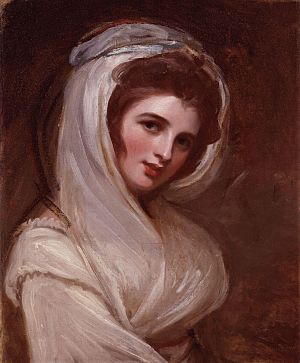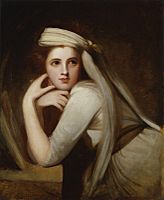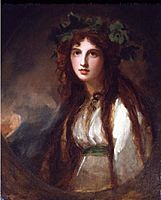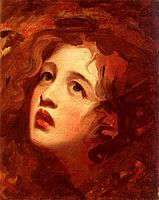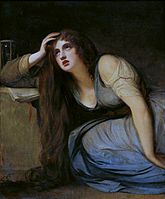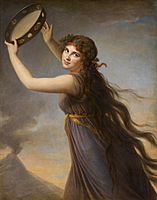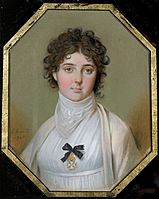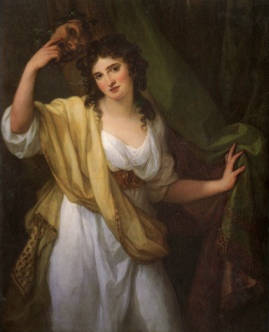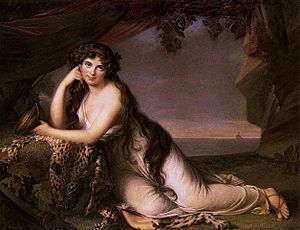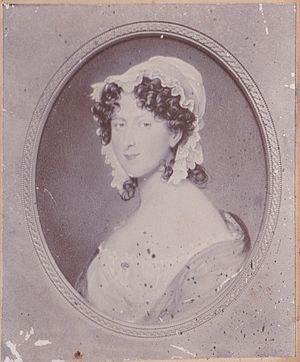Emma, Lady Hamilton facts for kids
Quick facts for kids
Lady Hamilton
|
|
|---|---|
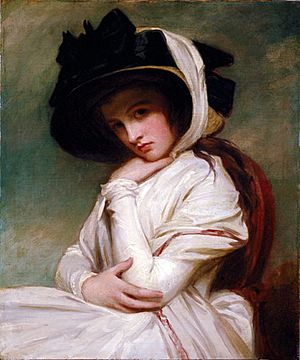
Portrait as a girl (aged seventeen)
by George Romney, c. 1782 |
|
| Born |
Amy Lyon
26 April 1765 Ness, Cheshire, England
|
| Died | 15 January 1815 (aged 49) Calais, France
|
| Other names | Emma Hart |
| Known for | Close friend and companion of Lord Nelson |
| Title |
|
| Spouse(s) | |
| Children |
|
Dame Emma Hamilton (born Amy Lyon; 26 April 1765 – 15 January 1815) was an English maid, model, dancer, and actress. She was known as Emma Hart when she moved to London. After marrying, she became Lady Hamilton. She was the favorite model for the famous portrait painter George Romney.
In 1791, at age 26, Emma married Sir William Hamilton. He was the British ambassador to the Kingdom of Naples. Emma became very popular at the royal court there. She became friends with the queen, who was a sister of Marie Antoinette. It was in Naples that she first met Lord Nelson.
Contents
Emma's Early Life
Emma was born Amy Lyon in Ness, England. Her father, a blacksmith, died when she was only two months old. She was raised by her mother, Mary Kidd, and her grandmother in Hawarden. Emma did not go to school. Later, she started using the name Emma Hart.
When Emma was 12, her grandmother was struggling to make money. Emma's mother had moved to London. So, Emma began working as a maid in Hawarden for a surgeon named Honoratus Leigh Thomas.
Emma later became friends with Charles Francis Greville. Emma lived in a small house in Paddington Green, London, which was a village outside the city. Greville asked her to change her name to "Mrs Emma Hart." He also wanted her to dress simply and avoid a busy social life. He arranged for Emma's mother to live with them as a housekeeper. Greville also taught Emma how to speak more clearly. After a while, he started inviting friends to meet her.
Greville saw a chance to make money. He sent Emma to pose for his friend, the painter George Romney. Romney was looking for a new model. Emma became the subject of many of Romney's most famous paintings. She quickly became a big celebrity in London. Romney became fascinated with her. He drew her in many poses, even when she wasn't there. Through Romney's popular art, Emma became well-known in society. People knew her as "Emma Hart." She was smart, witty, and a quick learner. Paintings show she was also very beautiful. Romney loved her looks and her ability to pose in different ways.
In 1783, Greville needed to marry a rich woman to improve his money situation. He found an 18-year-old heiress named Henrietta Middleton. Emma was a problem for him. People knew she was his companion because of her fame from Romney's paintings. His future wife would not accept him if he lived openly with Emma.
To get Emma to leave, Greville convinced his uncle, Sir William Hamilton, to take her in. Sir William was the British Ambassador to Naples. Sir William was 55 and had recently lost his wife. Emma's beauty was already famous to him. He even paid for her trip to Naples to make sure she arrived quickly. He had been happily married and enjoyed female company. His home in Naples was known for being welcoming and refined. He needed a hostess for his social gatherings. He thought Emma would be perfect.
Greville did not tell Emma his full plan. In 1785, he suggested the trip as a long holiday in Naples. He said he would be away in Scotland on business. Emma's mother had just had a stroke. So, Emma was sent to Naples, supposedly for six to eight months. She didn't realize she was going to be the companion of her host. Emma, her mother, and Gavin Hamilton left for Naples on March 13, 1786. They traveled overland in an old coach. She arrived in Naples on her 21st birthday, April 26.
Marriage to Sir William Hamilton
Emma lived in apartments in the Palazzo Sessa with her mother for about six months. She kept asking Greville to come and get her. Eventually, Emma understood that he had left her. She was very angry when she realized Greville's plan. But she slowly began to enjoy life in Naples. She started to respond to Sir William's strong interest in her around Christmas 1786. They fell in love. Sir William decided he wanted her to stay permanently. Emma moved into his apartments, while her mother stayed downstairs. Emma could not yet attend Court, but Sir William took her to every other party and outing.
They returned to England to get married. They needed the King's permission. They were married on September 6, 1791, at St Marylebone Parish Church. Emma was 26, and Sir William was 60. Even though she had to use her birth name, Amy Lyon, on the marriage record, the wedding gave her the title Lady Hamilton. She used this title for the rest of her life. Sir William's career was at its peak. During their visit, he became a member of the Privy Council. Soon after the wedding, Romney painted his last portrait of Emma from life, called The Ambassadress. After this, he became very sad and drew many sketches of Emma.
The newly married couple returned to Naples after two days.
Meeting with Nelson
As the wife of the British Ambassador, Emma welcomed Nelson to Naples. He arrived on September 10, 1793, to gather more forces against the French. Nelson had been married to Fanny Nisbet for about six years. An 18-year-old named Elizabeth Wynne described Emma in her diary in 1797. She called Emma "a charming woman, beautiful and exceedingly good humoured and amiable." When Nelson left for Sardinia on September 15, after only five days, it was clear he had already started to fall in love.
After four years of marriage, Emma wished she could have children with Sir William. She wrote that he was "the best husband and friend."
Nelson returned to Naples five years later, on September 22, 1798. He was a living legend after his victory at the Battle of the Nile. His step-son, Josiah Nisbet, who was 18, came with him. By this time, Nelson's adventures had aged him. He had lost an arm and most of his teeth. He also had coughing fits. Before he arrived, Emma had written a letter expressing her great admiration for him. Nelson even wrote warmly about Emma to his wife, with whom he was growing apart. Emma and Sir William took Nelson to their home, the Palazzo Sessa.
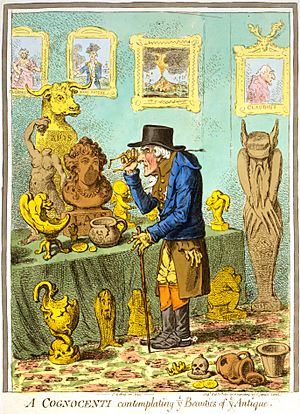
Emma cared for Nelson in her husband's home. She organized a party with 1,800 guests to celebrate his 40th birthday on September 29. After the party, Emma became Nelson's secretary and helped him with political matters. They soon became very close.
Emma had become a close personal friend of Queen Maria Carolina. She also gained important political influence. She advised the queen on how to deal with threats from the French Revolution. Queen Maria Carolina's sister, Marie Antoinette, had been a victim of the Revolution.
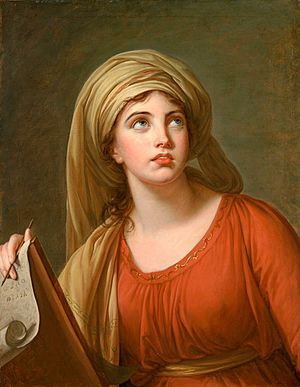
In 1799, Naples had a revolution. The common people did not support it. French troops were not welcome, but the royal family fled to Sicily. From Sicily, Nelson tried to help the royal family stop the revolutionaries. He did not have support from the British government. He even allowed one of the revolution's leaders, Admiral Francesco Caracciolo, to be executed for treason. Emma played an important role in ending the revolution. She arrived near Naples with Nelson's fleet on June 24, 1799. She carried messages between the queen and Nelson.
Life in London and at Merton
Nelson was called back to Britain shortly after. At the same time, the government finally allowed Sir William Hamilton to leave his post in Naples. Emma likely became pregnant around April 1800. Nelson, Emma, her mother, and Sir William traveled together. They took a long route back to Britain through Central Europe. They heard a famous piece of music by Joseph Haydn, now called the "Nelson Mass," in Vienna in 1800. They also met the composer. They finally arrived in Yarmouth to a hero's welcome on November 6, 1800.
The Hamiltons moved into a mansion at 22 Grosvenor Square. Nelson and his wife Fanny rented a house at 17 Dover Street. In December, Sir William rented a home at 23 Piccadilly. On January 1, Nelson became a vice admiral. He prepared to go to sea that night. Fanny gave him an ultimatum: choose between her and Emma. Nelson chose Emma. He decided to separate from his wife. He never saw Fanny again. While at sea, Nelson and Emma wrote many letters. They used a secret code to talk about Emma's condition. Emma kept her first daughter, Emma Carew, a secret from Nelson. Sir William continued to support Emma Carew.
Birth of Horatia
Emma gave birth to Nelson's daughter, Horatia, on January 29, 1801. This happened at 23 Piccadilly. Horatia was soon taken to a Mrs. Gibson for care.
By the autumn of 1801, Nelson bought Merton Place. It was a small house near Wimbledon. He bought it for £9,000, borrowing money from a friend. He let Emma spend freely to improve the property. Her goal was to make the house a tribute to his greatness. Emma worked to win over Nelson's family. She nursed his 80-year-old father, Edmund, for 10 days at Merton. Edmund loved her and thought about moving in with them. But he couldn't leave his home in Norfolk. Emma also helped Nelson's sisters, Kitty and Susanna. She helped raise their children and manage their money. Nelson's sister-in-law, Sarah, also asked him for help. This included paying for her son Horatio's school fees at Eton. Around this time, Emma finally told Nelson about her daughter, Emma Carew. She found she had nothing to worry about. Nelson invited Emma Carew to stay at Merton. He soon grew fond of "Emma's relative." An old letter shows Nelson took responsibility for young Emma's care.
After the Treaty of Amiens on March 25, 1802, Nelson was released from active service. But he wanted to keep his high position in society by appearing wealthy. Emma worked hard to make this dream a reality. Nelson's father became very ill in April. But Nelson did not visit him in Norfolk. He stayed home to celebrate Emma's 37th birthday. His father died on that very day. Nelson did not attend his father's funeral.
Death of Sir William
Newspapers reported on their every move. This included trips to Wales to see Sir William's properties. They also took a holiday to Ramsgate for some peace and quiet. People looked to Emma to set trends in fashion, home decor, and even dinner party menus. By the autumn of 1803, Sir William's health was getting worse. At the same time, the peace with France was breaking down. A "Children's Ball" was held after New Year for Horatia. A concert for 100 guests was staged in February.
Soon after, Sir William collapsed at 23 Piccadilly. He died on April 6 in Emma's arms. Charles Greville was in charge of Sir William's estate. He told Emma to leave 23 Piccadilly. But to keep up appearances, she needed a separate address from Nelson's. So, she moved into 11 Clarges Street, nearby, a couple of months later. The artist Le Brun visited Emma in 1802. She noted that Emma did not seem truly sad about her husband's death. She also remarked that Emma had 'grown horribly fat' since their last meeting in Naples.
Nelson had been offered command of the Mediterranean Fleet. They quickly had Horatia christened at Marylebone Parish Church before he left. On her baptism record, her name was Horatia Nelson Thompson. Her birth date was falsely recorded as October 29, 1800. This was to pretend she was born in Naples and was a godchild of Emma and Nelson. Nelson later wrote a letter saying the child was an orphan "left to his care and protection" in Naples.
Emma planned, paid for, and hosted the wedding of Nelson's niece, Kitty Bolton. Kitty married Captain Sir William Bolton. This happened at 23 Piccadilly on May 18, 1803. This was the same day Nelson left early in the morning to fight in the Napoleonic Wars. Emma was pregnant with their second child, though neither knew it then. The marriage was witnessed by Charlotte Mary Nelson and Emma Hartley (Emma's daughter, Emma Carew).
Nelson at Sea Again
Emma was very lonely. She was busy trying to make Merton Place the grand home Nelson wanted. She suffered from several illnesses. She was desperate for his return. The second child, a girl (reportedly named Emma), died about six weeks after her birth in early 1804. Horatia became ill at her home with Mrs. Gibson. Emma kept the baby's death a secret from the public. Her burial was not recorded. She kept her deep sadness from Nelson's family. She found it harder and harder to cope alone.
Emma received several marriage proposals in 1804. All the men were wealthy. But she was still in love with Nelson. She believed he would become rich from prize money and leave her wealthy in his will. So, she refused them all.
After a short visit to England in August 1805, Nelson had to return to duty. Emma received letters from him on October 1, 7, and 13. On his ship, he wrote a note for his will. He asked that, because of his service to King and Country, they should give Emma "ample provision to maintain her rank in life." He also asked that his "adopted daughter, Horatia Nelson Thompson...use in future the name of Nelson only."
Nelson's Death
On October 21, 1805, Nelson's fleet defeated a combined French and Spanish naval force. This was at the Battle of Trafalgar. Nelson was badly wounded during the battle and died three hours later. When the news of his death reached London, a messenger was sent to Merton Place. He was to tell Lady Hamilton. She later remembered:
They brought me word, Mr Whitby from the Admiralty. 'Show him in directly,' I said. He came in, and with a pale countenance and faint voice, said, 'We have gained a great Victory.' – 'Never mind your Victory,' I said. 'My letters – give me my letters' – Captain Whitby was unable to speak – tears in his eyes and a deathly paleness over his face made me comprehend him. I believe I gave a scream and fell back, and for ten hours I could neither speak nor shed a tear.
Emma lay in bed, overwhelmed with grief, for many weeks. She often received visitors while crying. It was weeks before she heard that Nelson's last words were of her. He had begged the nation to take care of her and Horatia. After Nelson's brother William and his wife Sarah distanced themselves from her, she relied on Nelson's sisters for support. Like her, the Boltons and Matchams had spent a lot of money expecting Nelson's return. Emma gave them and other friends money.
Emma's Later Years
Nelson's will was read in November. William inherited his entire estate, except for Merton. He also got Nelson's bank accounts and belongings. The government had made William an Earl and his son Horatio a Viscount. These were titles Nelson had wanted. William also became Duke of Bronte. Emma received £2000, Merton, and £500 per year from the Bronte estate. This was much less than she had when Nelson was alive. It was not enough to keep Merton. Even though Nelson was a national hero, his requests to the government to provide for Emma and Horatia were ignored. They also ignored his wish for her to sing at his funeral.
The funeral was very grand, costing the state £14,000. But Emma was not allowed to attend. Only the men of the Bolton and Matcham families were invited. Emma spent the day with her family and the women. She hosted dinner and breakfast for both families and housed the Boltons.
After the funeral, Emma started receiving many requests for money. William would not help, so everyone turned to Emma. Lord Grenville sent Nelson's will codicil to his lawyer, saying nothing could be done. Instead, the Boltons and Matchams each received £10,000. They still left their teenage daughters with Emma to educate. William was given £100,000 to buy an estate called Trafalgar. He also received £5000 for life.
Relations between William and Emma became difficult. He refused to give her the £500 pension she was due. Emma was especially hurt by Lady Charlotte's rejection. This was partly because Emma had spent about £2000 on her education, clothes, gifts, and holidays. She had also grown fond of her.
From 1806 to 1808, she kept up appearances. She continued to spend on parties and changes to Merton to make it a monument to Nelson. Goods Nelson had ordered arrived and had to be paid for. The yearly payment of £800 from Sir William's estate was not enough to pay off her debts and maintain her lifestyle. Emma fell deeply into debt.
She moved from Clarges Street to a cheaper home at 136 Bond Street. But she could not bring herself to give up Merton. Her brother, William, forced her to give him money. Her mother's sister's family, the Connors, also expected money. Emma Carew came for a short summer visit in late June 1806. At that time, Sir Harry Fetherstonhaugh sent £500 for Emma and her daughter. Emma hosted and hired James Harrison for six months to write a two-volume Life of Nelson. This book made it clear that Horatia was Nelson's child. She continued to entertain at Merton, including the Prince of Wales and the Dukes of Sussex and Clarence. But the royals did not return any favors.
Within three years, Emma was more than £15,000 in debt. In June 1808, Merton failed to sell at auction. She was not completely without friends. Her neighbors helped her. Sir John Perring hosted a group of important financiers. They helped organize her money and sell Merton. It was finally sold in April 1809. However, her lavish spending continued. Also, people kept taking advantage of her money. This meant she remained in debt, though most people didn't know. Her mother, Mrs. Cadogan, died in January 1810. For most of 1811 and 1812, she was almost in a debtors' prison. In December 1812, she either chose to go to prison or was sentenced to a prison term at the King's Bench Prison in Southwark. However, she was not kept in a cell. She was allowed to live in rooms nearby with Horatia. This was a system where well-off prisoners could pay to live "within the Rules," a three-square-mile area around the prison.
In early 1813, she asked the Prince of Wales, the government, and friends for help. But all her requests failed. She had to have an auction of many of her belongings, including many Nelson items, at low prices. However, she continued to borrow money to keep up appearances. Public opinion turned against her after the Letters of Lord Nelson to Lady Hamilton were published in April 1814.
Emma was eager to leave the country. But she risked arrest if she traveled on a normal ferry. So, she and Horatia hid from her creditors for a week. Then they boarded a private ship going to Calais on July 1, 1814. She had £50 in her purse. She first took expensive apartments at Dessein's Hotel. She initially kept up a social life and fine dining by relying on creditors. Her old housekeeper, Dame Francis, came to run the household and hired other servants. However, she soon fell deeply into debt. She also suffered from long-term health problems, including stomach pains. She turned to the Roman Catholic church and joined the St Pierre congregation.
Death
In November, they moved into a cheap flat at 27 Rue Française. Emma died on January 15, 1815, at age 49. She was buried in Calais on January 21 in a public burial ground outside the town. Her friend Joshua Smith paid for a simple funeral at the local Catholic church. Her grave was later lost due to wartime damage. But in 1994, a dedicated group unveiled a memorial. It stands today in the Parc Richelieu in her honor.
Henry Cadogan cared for 14-year-old Horatia after Emma's death. He paid for her travel to Dover. The Matchams took her in to care for their younger children. Two years later, she was sent to live with the Boltons, as Susanna had died in 1813. Horatia later married Rev. Philip Ward. She had 10 children, the first named Horatio Nelson. She lived until 1881. Horatia never publicly said that she was Emma Hamilton's daughter.
Jason M. Kelly summarized her life: "In a world of aristocratic privilege and powerful men, her common birth and gender ultimately limited her choices."
Honors and Titles
Emma Hamilton is usually known as Lady Hamilton. She gained this courtesy title in 1791 as the wife and later widow of Sir William Hamilton. In 1800, she became "Dame Emma Hamilton." This was a title she held in her own right. She became a female member of the Order of Malta. This was an unusual honor. The Grand Master of the Order, Tsar Paul, gave it to Lady Hamilton. It was to recognize her help in defending the island of Malta against the French.
After this, she used her new title in formal situations. She was recognized as Dame Emma Hamilton in official British contexts. Most notably, she was formally given her own coat of arms by the English College of Arms in 1806. The description of her coat of arms is Per pale Or and Argent, three Lions rampant Gules, on a chief Sable, a Cross of eight points of the second. The lions clearly refer to her maiden name, Lyons. The addition of the Maltese Cross puzzled experts who didn't know about her connection to the Order. But it is known as an honorable addition referring to her damehood.
Images for kids
-
Lady Hamilton as Ariadne by Élisabeth Vigée-Lebrun, 1790
-
A Cognocenti contemplating ye Beauties of ye Antique (1801), a funny drawing by James Gillray
-
'Lady Hamilton as the Persian Sibyl', 1792, by Élisabeth Vigée Le Brun


